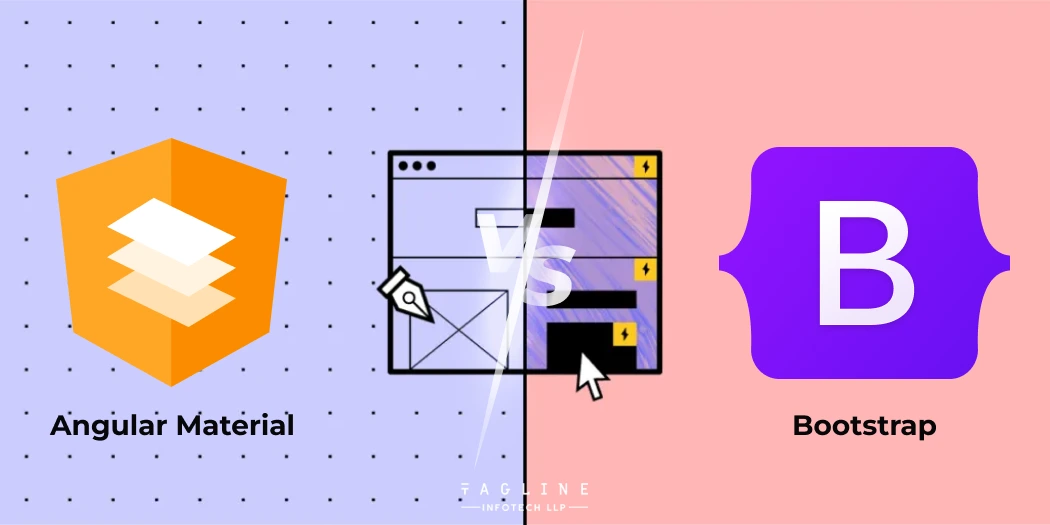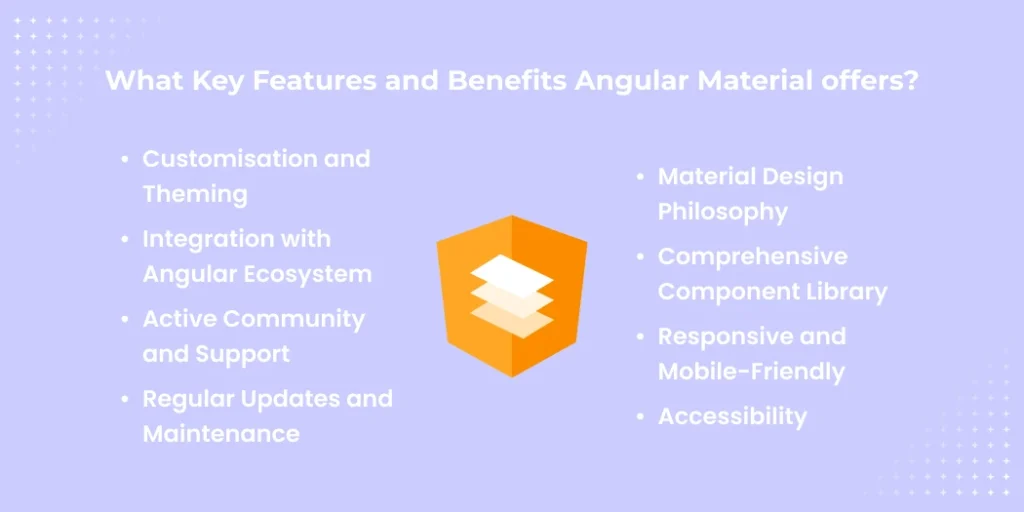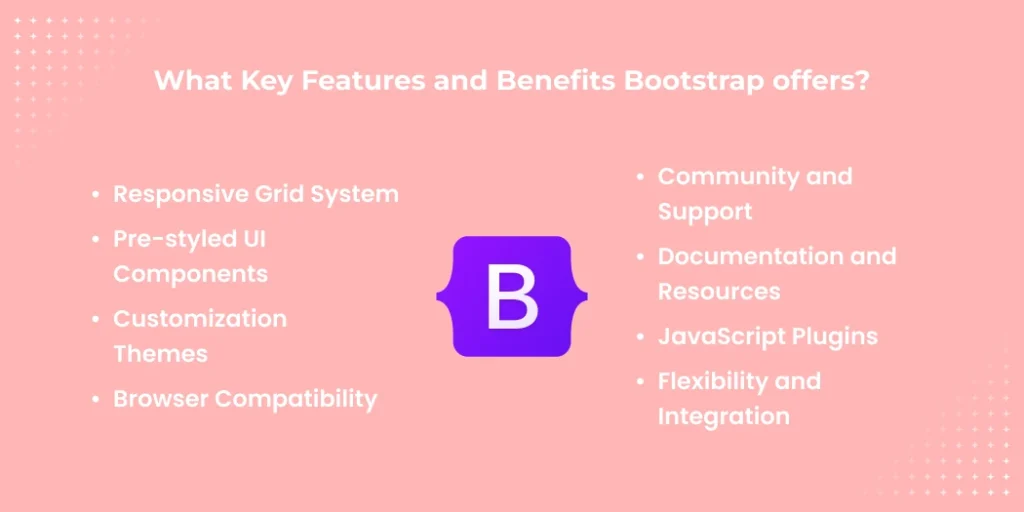Role of Python Libraries in Image Processing
October 30, 2025
Home >> AngularJS >> Angular Material vs Bootstrap: A Detailed Comparison

Quick Summary
An interactive and engaging front end is important for giving your users a better experience. Angular Material vs Bootstrap presents a crucial choice for developers, as both are incredibly good tools for building responsive and high-quality websites. However, which one fits better with your application? This blog dives deep into Bootstrap vs Angular Material, comparing their features and benefits to help you choose the right framework for your next project.
Angular Material is a prominent UI component library among Angular Component Libraries, developed by the Angular team at Google. It emphasizes guidelines provided by Google’s Material Design, enabling developers to achieve smooth and responsive user interfaces when creating responsive designs. It achieves this through the grid system and the provision of numerous components, making development in the Angular framework light and efficient for responsive websites.

This makes it possible for developers to turn on and off the look of Angular Material components so that they can have a matching brand or design requirement. Its theming system makes it change the color, and font, among other things that give room for customization.
Since Angular Material is designed for Angular, it seamlessly interoperates with any of Angular’s tools like dependency injection and data binding and hence works well while aiding you in easy development.
With a massive community of developers, Angular Material gives you a shot at getting help and tutorials when the road gets tough.
The Angular Material team rolls out upgrades that improve performance, fix bugs, and add new features. Your project stays updated and stable.
Applying the philosophy of Google’s Material Design for clean, aesthetically appealing UI/UX. Simple design patterns, fluid animations, and intuitive interactions help to make web applications user-friendly and professional.
The pre-built UI includes a set of libraries with everything from the most basic elements such as buttons and cards to more complex ones such as menus and tables. They are ready for use since developers don’t have to code them from scratch, thereby increasing the pace of development.
All Angular Material components are implemented so they don’t care about the device from desktops to smartphones. This means that your application will look pretty and work fine no matter the screen size.
Angular Material provides built-in accessibility features such as keyboard navigation and support for screen readers, so you can easily create apps accessible to everyone, including users with disabilities.
Angular Bootstrap was developed by Twitter and has now, over time, become one of the most widely used front-end frameworks. It is also known for quick development and flexibility. An Angularjs Development Company can leverage Bootstrap to enhance the user interface of applications efficiently.
Bootstrap offers a toolkit that ensures the production of good-quality CSS and JavaScript components, creating easy responses in terms of mobile-first websites. From the simplest landing page to complex web applications, Angular Bootstrap provides structure and tools to make building more efficient.

Simple to implement responsive layouts due to its base grid system. It uses a 12-column structure that adapts nicely across different screen sizes so your site will look as fantastic on your mobile phone as it will on your desktop.
Bootstrap provides many pre-designed elements, including buttons, forms, navigation bars, and alerts. This way you save time and labor because you only need to quickly deploy popular interface features without custom development from scratch.
With Sass-based variables and mixins, Bootstrap can be flexible and customized quite easily regarding colors, fonts, or spacing to match the design and branding of your project.
Bootstrap works smoothly across modern browsers and provides built-in fixes for older ones, ensuring consistent performance across different platforms.
With a large developer community, Bootstrap offers plenty of resources, such as forums, tutorials, and extensions. This support helps developers overcome challenges and extend Bootstrap’s functionality.
Bootstrap provides detailed documentation that includes examples and explanations for each component. This makes it easy for developers to learn how to use Bootstrap and troubleshoot issues.
Several JavaScript plugins add interactive features such as modals, carousels, and tooltips, thus making the user experience easy to implement.
All frontend frameworks are integrated well with Bootstrap, including Angular, React, and Vue.js for that flexibility, along with responsive design and UI components.
Angular Material sticks to Google’s Material Design guidelines, offering a clean and consistent interface. The components within the UI are designed to refine the user experience across multiple devices. Consequently, it is highly appropriate for projects that entail structured design demands and visual aspects.
Bootstrap is developed by Twitter and is used to create responsive layouts, which are mobile-first based on the principle of flexibility and are most effective for the easiest adaptation of different browsers.
Angular Material comes with a library specifically built for Angular apps, offering a variety of components like buttons, menus, and sliders. These components are designed following Material Design principles and integrate easily with Angular development tools.
Bootstrap offers a wide range of pre-designed UI components like forms, navigation bars, and dropdowns, which help speed up front-end development. These components can be customized with Sass, making Bootstrap suitable for projects across different frameworks.
Angular Materials built-in theming system allows developers to easily modify colors, fonts, and other design elements to match the project’s branding while keeping consistent with Material Design standards.
Bootstrap is known for its extensive customization options through Sass variables and mixins. Developers can modify every aspect of the design to fit their project’s needs, from color schemes to spacing, allowing for a unique look.
Accessibility is a core focus in Angular Material, which includes built-in features like ARIA attributes and keyboard navigation. This makes it easier to build applications that meet accessibility standards right from the start.
While Bootstrap offers accessibility support, achieving full compliance may require additional effort. Developers need to manually implement ARIA roles and other accessibility features to ensure an inclusive experience for all users.
Supported by Google and the Angular community, Angular Material has a strong backing with regular updates and extensive documentation. Developers have access to plenty of resources and community support to help with any challenges.
With a large global community, Bootstrap is highly popular, meaning there are numerous resources, plugins, and tutorials available. Its wide adoption makes it easy to find solutions, themes, and integrations for your project.
When working with Angular, aesthetics, consistency, and integration with Angular tools are the priorities, Angular Material would be ideal for enterprise applications or dashboards that need structure and accessibility.
It’s best suited for projects that require quick build-up, agility, and compatibility across different front-end frameworks. Bootstrap is ideal for startups, e-commerce platforms, or any other project calling for rapid prototyping and customization.
If your team is already comfortable with Angular or prefers its structured way of building apps, Angular Material is a solid choice. It fits perfectly within Angular’s ecosystem, providing a smooth development experience with tools like Angular CLI and TypeScript support.
For projects that need a clean and consistent user interface following Google’s Material Design principles, Angular Material offers a wide range of UI components designed for accessibility and visual appeal. This makes it ideal for applications where a uniform look across different sections is essential, such as enterprise tools, data dashboards, and admin interfaces. If accessibility is a priority, think of features like keyboard navigation and ARIA roles. Angular Material makes it easy to implement these elements, ensuring your app is user-friendly and inclusive from the start.
This is the best option when rapid prototyping demands and an unstable design change occur. Versatility ensures it can integrate well with any front-end technology, be it Angular, React, or simple HTML/CSS, which makes it the first choice of developers.
Bootstrap features the ability to develop faster with a large library of pre-styled components coupled with a responsive grid system, so you can make and develop UI elements in only a few minutes. The specific requirements of the project are met with the extensive availability of Sass variables and mixins for design flexibility. If you need flexibility, speedy deployment, and an active support community, I would recommend Bootstrap for your startup or small business.
Absolutely! To make the most of both frameworks, developers put together Bootstrap along with Angular to create applications that contain the look and feel of responsive design ready-made components from Bootstrap while having the feature richness from Angular. This way, you can develop dynamic, visually appealing applications that provide ways to a variety of project requirements. It is flexible in development terms also to cater to every type of need.
In conclusion, the choice between Angular Material and Bootstrap presents unique benefits suited to various development needs and preferences. If you favor Angular Material’s commitment to Material Design principles, you can ensure a polished and cohesive user interface. On the other hand, if you prioritize Bootstrap’s versatility and extensive customization options, you’ll find it an excellent tool for rapid development. Ultimately, both frameworks empower Angular developers to build impressive, user-centric web applications that align with contemporary design standards and exceed user expectations. To leverage these frameworks effectively, consider hiring AngularJS developers from Tagline Infotech, who can help you enhance your development projects and create engaging web experiences.
Angular: A framework for building web apps, focused on structure, data binding, routing, and more.
Angular Material: A UI library built for Angular, following Material Design guidelines to offer pre-built, customizable UI components like buttons, cards, and dialogs.
Angular: It has built-in i18n tools for translations, date, number, and currency formatting, making it easier to support multiple languages.
Bootstrap: It doesn't offer i18n support directly but can be paired with Angular’s i18n features to build responsive, multi-language applications.
Angular Material Alternatives:
PrimeNG
NG-ZORRO
Kendo UI
DevExtreme Angular
Bootstrap Alternatives:
Foundation
Bulma
Tailwind CSS
Semantic UI
Each offers its unique strengths, so pick based on your project needs.
Created with Solvase

Digital Valley, 423, Apple Square, beside Lajamni Chowk, Mota Varachha, Surat, Gujarat 394101
D-401, titanium city center, 100 feet anand nagar road, Ahmedabad-380015
+91 9913 808 2851133 Sampley Ln Leander, Texas, 78641
52 Godalming Avenue, wallington, London - SM6 8NW